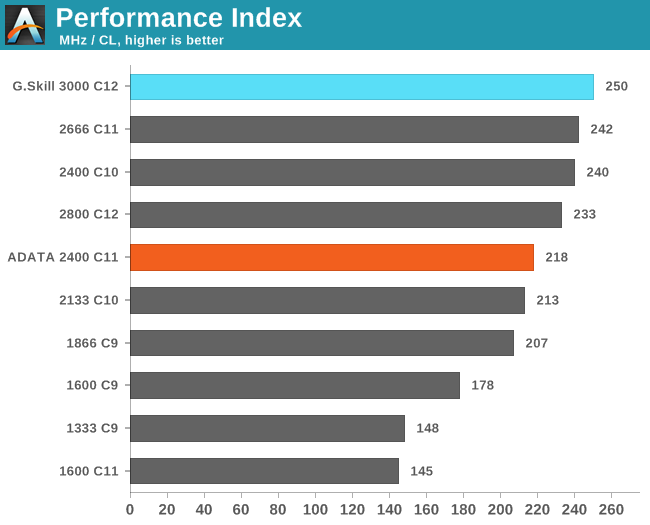ADATA XPG V2 Review: 2x8 GB at DDR3-2400 C11-13-13 1.65 V
by Ian Cutress on November 11, 2013 1:00 PM ESTMarket Positioning
As mentioned before, at current prices these modules will have a tough time in the turbulent memory market. On 11/7, the current prices for similar 2x8GB DDR3-2400 C11 memory kits were as follows (prices taken from Newegg):
$140 Mushkin Enhanced Blackline DDR3-2400 C11 2x8GB, Frostbyte
$140 ADATA XPG V2 DDR3-2400 C11 2x8GB, Tungsten Grey
$148 G.Skill Ripjaws X DDR3-2400 C11 2x8GB
$152 G.Skill Ares DDR3-2400 C11 2x8GB
$155 G.Skill Sniper DDR3-2400 C11 2x8GB
$156 ADATA XPG V2.0 DDR3-2400 C11 2x8GB, Gaming
$170 Silicon Power DDR3-2400 C11 2x8GB
$170 Mushkin Enhanced Blackline DDR3-2400 C11 2x8GB, Ridgeback
$200 ADATA XPG V2 DDR3-2400 C11 2x8GB, Gold
This makes for bleak reading, as these are the most expensive in the land of 2400 C11. It gets worse, looking at kits with a higher performance index:
$150 Team Xtreem LV DDR3-2400 C10 2x8 GB
$165 G.Skill Trident X DDR3-2400 C10 2x8 GB
$190 Mushkin Enhanced Redline DDR3-2400 C10 2x8GB
$200 ADATA XPG V2 DDR3-2400 C11 2x8GB, Gold
The conclusion from this data is obvious enough: ADATA need to push the price of this kit down to the $140-$150 mark in order to make any headway in sales.
Test Bed
| Processor |
Intel Core i7-4770K Retail @ 4.0 GHz 4 Cores, 8 Threads, 3.5 GHz (3.9 GHz Turbo) |
| Motherboards | ASRock Z87 OC Formula/AC |
| Cooling | Corsair H80i |
| Power Supply | Corsair AX1200i Platinum PSU |
| Memory | ADATA XPG V2 DDR3-2400 C11-13-13 1.65V 2x8 GB |
| Memory Settings | XMP |
| Discrete Video Cards |
AMD HD5970 AMD HD5870 |
| Video Drivers | Catalyst 13.6 |
| Hard Drive | OCZ Vertex 3 256GB |
| Optical Drive | LG GH22NS50 |
| Case | Open Test Bed |
| Operating System | Windows 7 64-bit |
| USB 3 Testing | OCZ Vertex 3 240GB with SATA->USB Adaptor |
Many thanks to...
We must thank the following companies for kindly donating hardware for our test bed:
Thank you to OCZ for providing us with 1250W Gold Power Supplies.
Thank you to Corsair for providing us with an AX1200i PSU, and Corsair H80i CLC
Thank you to ASUS for providing us with the AMD GPUs and some IO Testing kit.
Thank you to ECS for providing us with the NVIDIA GPUs.
Thank you to Rosewill for providing us with the 500W Platinum Power Supply for mITX testing, BlackHawk Ultra, and 1600W Hercules PSU for extreme dual CPU + quad GPU testing, and RK-9100 keyboards.
Thank you to ASRock for providing us with the 802.11ac wireless router for testing.
‘Performance Index’
In our Haswell memory overview, I introduced a new concept of ‘Performance Index’ as a quick way to determine where a kit of various speed and command rate would sit relative to others where it may not be so obvious. As a general interpretation of performance in that review, the performance index (PI) worked well, showing that memory kits with a higher PI performed better than those that a lower PI. There were a few circumstances where performance was MHz or CL dominated, but the PI held strong for kit comparisons.
The PI calculation and ‘rules’ are fairly simple:
- Performance Index = MHz divided by CL
- Assuming the same kit size and installation location are the same, the memory kit with the higher PI will be faster
- Memory kits similar in PI should be ranked by MHz
- Any kit 1600 MHz or less is usually bad news.
That final point comes about due to our previous testing - in several benchmarks in our Haswell memory overview performed very poorly (20% worse or more) with the low end MHz kits. In that overview, we suggested that an 1866 C9 or 2133 C10 might be the minimum suggestion; whereas 2400 C10 covers the sweet spot should any situation demand good memory.
With this being said, the results for our kits are as follows:

From the data in our memory overview, it was clear that any kit with a performance index of less than 200 was going to have issues on certain benchmarks. The ADATA kit has a PI of 218, which seems to be a happy medium around other kits that tend to hit either 200 or 240.










23 Comments
View All Comments
IanCutress - Tuesday, November 12, 2013 - link
BF4 will hopefully be part of my 2014 test bed, I'm still getting equipment arranged to make it relevant and trying to decide a consistent benchmark. Running through an empty server atm is the only consistent way, but it might not be considered a true representation of what's possible.d9ssk02md - Tuesday, November 12, 2013 - link
Well, on my sandy bridge it only took a year or two of running memory at 1.65V to develop random freezes. Lowering the voltage (and the speed) to 1.5V made the issue completely disappear.Gen-An - Tuesday, November 12, 2013 - link
A bit surprising these couldn't go higher, considering they are likely using Hynix H5TQ4G83MFR ICs. I have some sticks of the same bin (2400C11 2x8GB) but a different brand (Silicon Power) and I've been able to push them to 2933.